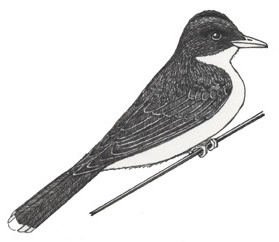

They breed from Northwest Territories across Canada, south through all of the eastern U.S., and the western states to northern Nevada, northern New Mexico, and southern Texas. They winter in South America.
They live in open fields, forest edges, farms, parks and roadsides.
They are dark above, white below with a black head and white tail tips.
They sit up high and swoop down after insects. They are aggressive, calling loudly.
They eat insects and may eat fruit.
They build an open cup of twigs, grass and place it in a tree or atop a fence post. The female lays 2 - 5 white eggs with dark spots.
Kingdom: Animalia
Phylum: Chordata
Subphylum: Vetebrata
Class: Aves
Order: Passeriformes
Family: Tyrannidae
Genus: Tyrannus
Species: T. tyrannus
When you research information you must cite the reference. Citing for websites is different from citing from books, magazines and periodicals. The style of citing shown here is from the MLA Style Citations (Modern Language Association).
When citing a WEBSITE the general format is as follows.
Author Last Name, First Name(s). "Title: Subtitle of Part of Web Page, if appropriate." Title: Subtitle: Section of Page if appropriate. Sponsoring/Publishing Agency, If Given. Additional significant descriptive information. Date of Electronic Publication or other Date, such as Last Updated. Day Month Year of access < URL >.
Amsel, Sheri. "Kingbird (Eastern)" Exploring Nature Educational Resource ©2005-2024. December 13, 2024
< http://www.exploringnature.org/db/view/Kingbird-Eastern >

